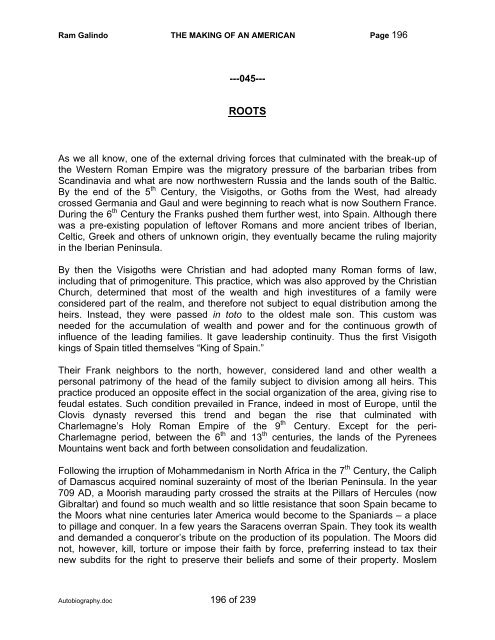Autobiography - The Galindo Group
Autobiography - The Galindo Group
Autobiography - The Galindo Group
You also want an ePaper? Increase the reach of your titles
YUMPU automatically turns print PDFs into web optimized ePapers that Google loves.
Ram <strong>Galindo</strong> THE MAKING OF AN AMERICAN Page 196<br />
---045---<br />
ROOTS<br />
As we all know, one of the external driving forces that culminated with the break-up of<br />
the Western Roman Empire was the migratory pressure of the barbarian tribes from<br />
Scandinavia and what are now northwestern Russia and the lands south of the Baltic.<br />
By the end of the 5 th Century, the Visigoths, or Goths from the West, had already<br />
crossed Germania and Gaul and were beginning to reach what is now Southern France.<br />
During the 6 th Century the Franks pushed them further west, into Spain. Although there<br />
was a pre-existing population of leftover Romans and more ancient tribes of Iberian,<br />
Celtic, Greek and others of unknown origin, they eventually became the ruling majority<br />
in the Iberian Peninsula.<br />
By then the Visigoths were Christian and had adopted many Roman forms of law,<br />
including that of primogeniture. This practice, which was also approved by the Christian<br />
Church, determined that most of the wealth and high investitures of a family were<br />
considered part of the realm, and therefore not subject to equal distribution among the<br />
heirs. Instead, they were passed in toto to the oldest male son. This custom was<br />
needed for the accumulation of wealth and power and for the continuous growth of<br />
influence of the leading families. It gave leadership continuity. Thus the first Visigoth<br />
kings of Spain titled themselves “King of Spain.”<br />
<strong>The</strong>ir Frank neighbors to the north, however, considered land and other wealth a<br />
personal patrimony of the head of the family subject to division among all heirs. This<br />
practice produced an opposite effect in the social organization of the area, giving rise to<br />
feudal estates. Such condition prevailed in France, indeed in most of Europe, until the<br />
Clovis dynasty reversed this trend and began the rise that culminated with<br />
Charlemagne’s Holy Roman Empire of the 9 th Century. Except for the peri-<br />
Charlemagne period, between the 6 th and 13 th centuries, the lands of the Pyrenees<br />
Mountains went back and forth between consolidation and feudalization.<br />
Following the irruption of Mohammedanism in North Africa in the 7 th Century, the Caliph<br />
of Damascus acquired nominal suzerainty of most of the Iberian Peninsula. In the year<br />
709 AD, a Moorish marauding party crossed the straits at the Pillars of Hercules (now<br />
Gibraltar) and found so much wealth and so little resistance that soon Spain became to<br />
the Moors what nine centuries later America would become to the Spaniards – a place<br />
to pillage and conquer. In a few years the Saracens overran Spain. <strong>The</strong>y took its wealth<br />
and demanded a conqueror’s tribute on the production of its population. <strong>The</strong> Moors did<br />
not, however, kill, torture or impose their faith by force, preferring instead to tax their<br />
new subdits for the right to preserve their beliefs and some of their property. Moslem<br />
<strong>Autobiography</strong>.doc 196 of 239


